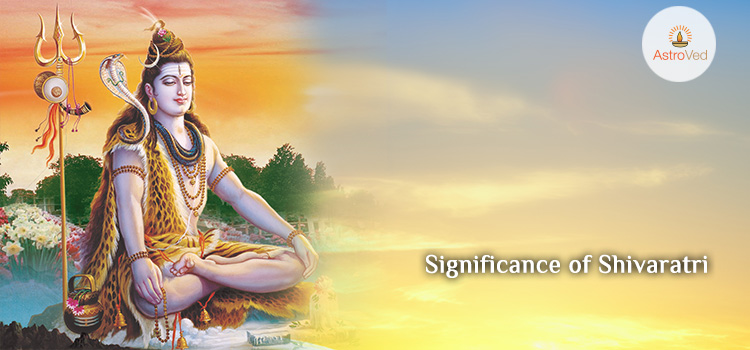What is Mahashivaratri?
There are 12 Shivaratris in a year that are meant for the worship of Lord Shiva. Mahashivaratri, also called ‘the great night of Shiva,’ is the most important of these. It occurs in the Hindu month of Magha (Feb-March). Hindus celebrate it on the night before the new moon day in this month.
Legend behind Mahashivaratri
There are many legends relating to Maha Shivaratri. As per one legend, during the churning of the Milky Ocean, a deadly poison emerged from the ocean. To prevent it from destroying the universe, Shiva drank the deadly poison. However, he did not swallow it but held it in his throat. The poison made him turn blue. It explains why Shiva got the name ‘Neelakantha,’ meaning 'the blue-throated one.'
Another legend claims that the wedding of Shiva and Parvati took place on this day. It is also said that Shiva took rest after performing his cosmic dance, Tandava, on the day of Mahashivaratri. Yet another legend is related to a fight between Brahma and Vishnu regarding supremacy. Shiva had to intervene to resolve the argument, and he also punished Brahma for telling a lie to claim that he was the supreme deity.
Astrological Significance of Mahashivaratri
On the night of Mahashivaratri, the planets align in such a manner that they make it possible for people to achieve an intense spiritual awakening. The planetary positions generate a powerful upsurge of energy. At this time, our consciousness supposedly peaks. Hence, devotees observe an all-night vigil to tap into this energy through meditation and chanting sacred hymns.
The belief is that by staying erect and keeping one’s spine erect, one can access this energy. In the sleeping position, we cannot maintain an erect spine, which is why people stay awake on this holy and powerful night. Many chant the Mantra "Om Namah Shivaya" and other Shiva Mantras. Devotees also sing songs, Bhajans, and dance during Mahashivaratri to keep them awake and absorb the positive vibes.
Elimination of Negative Gunas
There are 3 major Gunas in Hinduism.
Sattva: This Guna represents the virtue of goodness and has associations with positive and constructive qualities.
Rajas: Rajas Guna signifies egoistic tendencies and the actions we do for our own pleasure.
Tamas: Tamas signifies evil and destructive actions.
Most human beings have a mix of these gunas. Sometimes, one of these 3 Gunas may be dominant in a person, making them either virtuous or evil.
Qualities like creativity, calmness, and purity come under Sattva. Tamas represents idleness, laziness, and inactivity.
On Mahashivaratri, Shiva helps us to remove all negativity in life. His divine power comes into play and eradicates Tamasic and Rajasic elements from our lives.
Significance of Ananda Tandava
Nataraja is another form of Shiva – the cosmic dancer. He performs the Ananda Tandava when he is in a good mood and the Rudra Tandava when he is in a bad mood. Ananda Tandava enacts the cycle of creation and destruction in the world.
Shiva as Nataraja dances on top of a dwarf called Apasmara, thereby displaying his victory over ignorance. Shiva suppresses ignorance, and this ability of Shiva to destroy ignorance and idiocy enables him to bring out the creativity and potential in a true devotee on the occasion of Mahashivaratri.
Mantras for Mahashivratri
Devotees usually recite the Panchakshara Mantra during Mahashivaratri.
The Mantra - “Om Namah Shivaya”. It has 5 syllables and means, ’I bow down in worship to Lord Shiva’. It has another meaning, too. Taking each syllable, it denotes the Pancha Boothas or 5 elements in nature.
Na: Na means ‘earth’
Ma: means ‘water’
Si: means ‘fire’
Va: means ‘air’
Ya: Ya means ‘ether’
Benefits of Panchakshara Mantra
∙ It can remove the fear of death.
∙ It can heal all diseases.
∙ It strengthens the mind, body, and soul.
∙ It bestows mental clarity and sound judgment.
∙ It enables one to make the right decisions in life.
∙ It makes one more spiritual.
∙ It helps focus your energy.
∙ It brings inner peace and tranquility.
∙ It boosts memory and concentration power.
∙ It removes ego.
Rituals of Mahashivaratri
- There are many things to keep in mind when observing the fast, making offerings for Shiva, performing rituals, and chanting Mantras.
- Wake up early in the morning.
- Take a bath and visit a Shiva temple.
- Take part in the Pooja and make offerings.
- Bathe the Shivalinga with water, milk, saffron, honey, and holy water from Ganga.
- For the milk offering, always use ice-cold milk.
- Avoid table salt for cooking and use rock salt instead.
- Follow a Sattvik diet. Avoid onions and garlic.
- Do not eat any food after sunset on the day of Mahashivaratri.




.png)
0 Comments